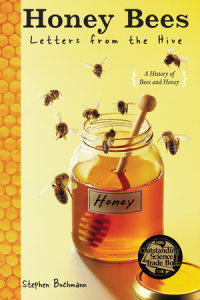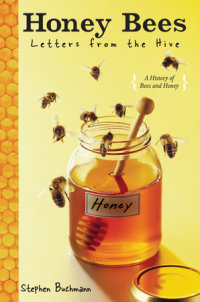Chapter 1
Secrets of the Bee: Abuzz with Activity
Oh, to Be a Bee!
Honey bees live in a world vastly different from ours. On a fresh spring morning a bee looks down on fields of colorful wildflowers through many-faceted compound eyes. A bee has five compound eyes, each with thousands of slender hairs growing from its surface. Through these hairy eyes, one would see vibrant colors and rapid movements inaccessible to the sensory powers of human beings.
While life on the wing could be magical, it would not be without risk. A bee could unwittingly fly into the snare of an orb-weaver spider's web or, ironically, find itself trapped in the folds of an entomologist's aerial net, condemned to the bitter-almond vapors of the killing jar.
Honey bees savor tastes ranging from sweet to sour and back again, not only through cells in their mouth but also through sensitive hairs on their antennae. Bees would smell not…
Chapter 1
Secrets of the Bee: Abuzz with Activity
Oh, to Be a Bee!
Honey bees live in a world vastly different from ours. On a fresh spring morning a bee looks down on fields of colorful wildflowers through many-faceted compound eyes. A bee has five compound eyes, each with thousands of slender hairs growing from its surface. Through these hairy eyes, one would see vibrant colors and rapid movements inaccessible to the sensory powers of human beings.
While life on the wing could be magical, it would not be without risk. A bee could unwittingly fly into the snare of an orb-weaver spider's web or, ironically, find itself trapped in the folds of an entomologist's aerial net, condemned to the bitter-almond vapors of the killing jar.
Honey bees savor tastes ranging from sweet to sour and back again, not only through cells in their mouth but also through sensitive hairs on their antennae. Bees would smell not through a big, protuberant nose but through thousands of minute sensory pits scattered across the surface of my antennae. This is called olfaction and is extremely important for bees. Without it, bees wouldn't be able to locate flowers as easily, recognize nest mates, smell an intruder in the colony, detect alarm pheromones given off by colleagues who have spotted danger. Floral scents cling to bees' hairy wax-covered bodies as insistently as the scent of a woman's perfume clings to a man's jacket after dancing close. When bees return to the hive after a successful foraging trip, the clinging fragrances inform their sisters of the kinds of blossoms they've visited during the day, a sort of travel log recording forays into floral landscapes, or bee pastures. More importantly, these scents help direct new recruits to the best sources of nectar and pollen.
The scents of the outside world don't mask the unique scent of the home nest, which is always there to serve as an olfactory identity badge. Guard bees sniff the body odor of workers returning from the field; if they smell something unfamiliar, the stranger is kept out or even attacked and killed if it persists in trying to enter.
Home Sweet Home: Life in the Hive
If we could shrink ourselves down to bee size and enter the inner world of the nest, we would find it an alien place, dark, crowded, and oppressively hot and humid. But bees are not humans, and presumably they feel comfortable in the hive, which is home to a queen, tens of thousands of her daughters (sterile worker bees), and a few hundred or so of her sons, the drones. Double-sided hexagonal combs hang like graceful parallel curtains from the ceiling of the hive. Like large corporations that house thousands of employees in diminutive side-by-side cubicles, the beeswax nest is a highly compartmented and efficient workplace. The waxen cubicles serve a multitude of functions, from honey and pollen storage pantries and larval nurseries to dance floors for the waggle dancing of returning foragers.
Waggle dancing is one of nature's most fascinating means of communication. When a successful forager returns from the field with a special stomach (the crop) full of nectar or bulging hind-leg pollen baskets, she performs a lively dance on the vertical combs--a little wag-tail movement followed by a straight upward run--that imparts information to the bees watching and listening to the show. The spectators routinely beg for a sip of nectar from the obliging dancer, who takes a break to pass out free samples.
Karl von Frisch, an Austrian animal behaviorist who shared a Nobel Prize in physiology and medicine in 1973, spent decades studying what he called the "dance language of the honey bees." Von Frisch determined that the straight-run portion of the waggle dance indicated the direction of the floral patch, while the vigor of the waggling, accompanied by pulsed buzzing vibrations, imparted the relative distance to the food. Dancing straight up on the combs indicated that the recruited bees should fly toward the sun to find the correct flowers. If the food was located in the opposite direction of the sun, the performer danced straight down on the combs of the nest. Odors also play a primary role in how bees locate and remember flowers. Foragers return to their nests with the lively scents of flowers clinging to their hairy bodies. Other bees smell these scents and it helps them to locate and recognize them far from the nest.
Beeswax, the building material of the hive's interior, is biochemically expensive to make. It takes almost twenty pounds of honey, digested and biochemically transformed in the bees' bodies (wax glands), to produce just one pound of the precious wax. This is why beekeepers often supply ready-made beeswax foundation sheets to their colonies--they'd rather have this honey for their own use, saving the bees some effort. Beeswax is secreted by eight paired glands under the abdomen of the bee, then chewed and softened until it is pliable enough to be shaped into the thin-walled hexagonal cells of the combs.
How the geometric combs are constructed by the workers without a supervisor, blueprints, rulers, or protractors remains a mystery. Previously, scientists believed that the precision of the hexagonal cells was the result of an instinctive behavior that stimulated the bees to add, remove, and fashion the wax in just the right way to ensure that the walls and angles were all perfectly aligned. Recently, it has been suggested that the hexagonal cells are an "emergent property," that is, at the right temperature (between 37 and 40 C), the hexagons form on their own. First the bees make cylindrical tubes around themselves and then the hexagonal angles form. Chemically, the beeswax transforms from an amorphous (or unorganized) state into a crystalline state. As strange as this sounds, look at the angles where soap bubbles touch one another to form 120-degree angles. Or roll out some clay cylinders the thickness of a pencil with your hands. Take ten or so and wrap them in a cardboard sleeve. Squeeze them together slowly. You get hexagons! Hexagons are found in other examples of animal architecture, like wasp nests or under the sea in the hard limey skeletons of corals.


